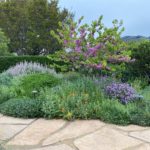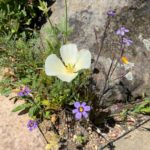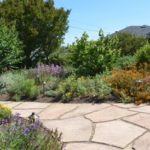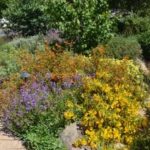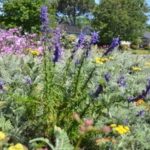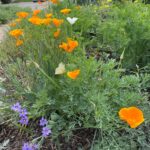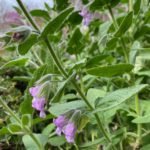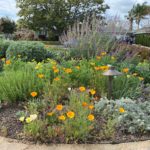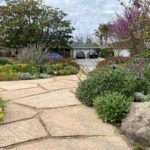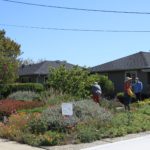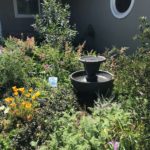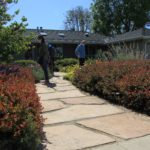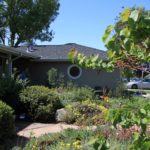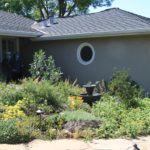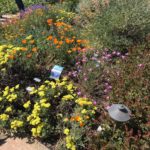Showcase Feature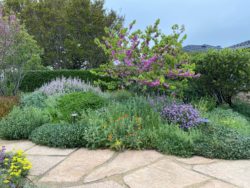
Joel, who had loved nature since he was a child, didn’t love the large lawn. With the droughts becoming more frequent, his neighbor’s beautiful native plant garden as a model, and a $1,200 lawn removal rebate from the Alameda County Water District, Joel took the plunge and did the thirsty lawn in. With the lawn gone, household water used dropped by two thirds—yet the garden looks full and lush.
The repetition, rhythm and continuity provided by drifts of three kinds of fuchsia, four types of sage and buckwheat, and five varieties of manzanita create a visual delight for two-legged passers-by, and a smorgasbord of nectar and pollen for winged visitors. The drifts—ribbons of the same plant that meanders across the landscape—give the garden a natural and calming feel. Yet this garden is also vibrant with color and texture; a rich, layered, and well-balanced mix of plants of different sizes, shapes, leaf type, and a diversity of greens and greys in pleasing arrays highlight the subtle beauty of our California native plants.
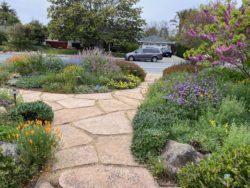 Joel’s garden has something in bloom almost year-round, and the wide and inviting flagstone path that wends through the garden provides opportunities to view the garden from a variety of vantage points. In January bees and hummingbirds are drawn to the urn-shaped, pink and cream-colored blossoms of the numerous manzanitas. Throughout spring the garden is a riot of pink clarkia, blue California lilac, orange monkeyflower, magenta hummingbird sage, and orange poppies. Summertime and early fall finds red California fuchsia, pink rosy buckwheats and bright yellow goldenrod in flower.
Joel’s garden has something in bloom almost year-round, and the wide and inviting flagstone path that wends through the garden provides opportunities to view the garden from a variety of vantage points. In January bees and hummingbirds are drawn to the urn-shaped, pink and cream-colored blossoms of the numerous manzanitas. Throughout spring the garden is a riot of pink clarkia, blue California lilac, orange monkeyflower, magenta hummingbird sage, and orange poppies. Summertime and early fall finds red California fuchsia, pink rosy buckwheats and bright yellow goldenrod in flower.
The garden is low-maintenance; Joel spends just a few hours a month weeding, pruning, and making adjustments to the garden according to his own sense of design. It is also water-conserving; only new plants are watered, as needed. This garden was initially designed by Annaloy Nickum but over the years most of the plants have been changed, and the garden you’ll see now was designed and planted by Joel.
Other Garden Attractions
· Mounds created from the former lawn provide visual interest, and the drainage that most natives need.
· Dense plantings out-compete weeds.
· Did you know that the Alameda County Water District is currently offering a rebate of $2.00 a sq. ft. for lawn removal?
Gardening for Wildlife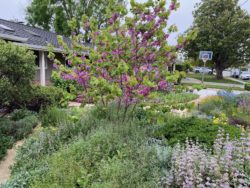
Butterflies such as the acmon blue, buckeye, and skippers are drawn to the large patches of plants, which are more attractive to them than a single specimen. Native bees gather pollen and nectar in the garden; hummingbirds sip nectar from the long, tubular blossoms of the fuchsia, penstemon and monkeyflower. Our local narrow-leafed milkweed has been planted for the endangered monarch butterfly—which can only lay its eggs on milkweed.
Keystone species in this garden (watch this talk by Doug Tallamy!)
Keystone species—our own, local ecological powerhouse plants— in this garden include California lilac, currant, manzanitas, snowberry, sages, buckwheats and goldenrod.
Green Home Feature!
SunWork installed a Rheem hybrid heat pump water heater in Joel’s garage; with rebates, the price was great!
Besides space heating and cooling, water heating is one of the top appliances using energy in the home. Especially if you have solar panels, this is a great reason to “electrify” your water heating, replacing your old gas-powered hot water heater with a heat pump.
Joel reports, “I like the new heat pump water heater: especially its ability to set a schedule and heat water at off peak times. Reuben from SunWork, who installed our heat pump, has been quite responsive. and he was very good to work with.”
Photos
Click to see as a slideshow:



